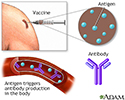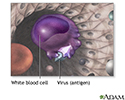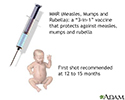Vaccines (immunizations) - overview
Vaccinations; Immunizations; Immunize; Vaccine shots; Prevention - vaccine
Vaccines are used to boost your immune system and prevent serious, life-threatening diseases.
Information
HOW VACCINES WORK
Vaccines "teach" your body how to defend itself when germs, such as viruses or bacteria, invade it:
- They expose you to a very small, very safe amount of viruses or bacteria that have been weakened or killed.
- Your immune system then learns to recognize and attack the infection if you are exposed to it later in life.
- As a result, you will not become ill, or you may have a milder infection. This is a natural way to deal with infectious diseases.
Four types of vaccines are currently available:
- Live virus vaccines use the weakened (attenuated) form of the virus. The measles, mumps, and rubella (MMR) vaccine and the varicella (chickenpox) vaccine are examples.
- Killed (inactivated) vaccines are made from a protein or other small pieces taken from a virus or bacteria. The flu vaccine is an example.
- Toxoid vaccines contain a toxin or chemical made by the bacteria or virus. They make you immune to the harmful effects of the infection, instead of to the infection itself. Examples are the diphtheria and tetanus vaccines.
- Biosynthetic vaccines contain manmade substances that are very similar to pieces of the virus or bacteria. The Hib ( Haemophilus influenzae type B) conjugate vaccine is an example.
WHY WE NEED VACCINES
For a few weeks after birth, babies have some protection from germs that cause diseases. This protection is passed from their mother through the placenta before birth. After a short period, this natural protection goes away.
Vaccines help protect against many diseases that used to be much more common. Examples include tetanus, diphtheria, mumps, measles, pertussis (whooping cough), meningitis, and polio. Many of these infections can cause serious or life-threatening illnesses and may lead to life-long health problems. Because of vaccines, many of these illnesses are now rare.
SAFETY OF VACCINES
Some people worry that vaccines are not safe and may be harmful, especially for children. They may ask their health care provider to wait or even choose not to have the vaccine. But the benefits of vaccines far outweigh their risks.
The American Academy of Pediatrics, the Centers for Disease Control and Prevention (CDC), and the Institute of Medicine all conclude that the benefits of vaccines outweigh their risks.
Vaccines, such as the measles, mumps, rubella, chickenpox, and nasal spray flu vaccines contain live, but weakened viruses:
- Unless a person's immune system is weakened, it is unlikely that a vaccine will give the person the infection. People with weakened immune systems should not receive these live vaccines.
- These live vaccines may be dangerous to the fetus of a pregnant woman. To avoid harm to the baby, pregnant women should not receive any of these vaccines. The provider can tell you the right time to get these vaccines.
Thimerosal is a preservative that was found in most vaccines in the past. But now:
- Only one third of flu shots still have thimerosal.
- NO other vaccines commonly used for children or adults contain thimerosal.
- Research done over many years has NOT shown any link between thimerosal and autism or other medical problems.
Allergic reactions are rare and are usually to some part (component) of the vaccine.
VACCINE SCHEDULE
The recommended vaccination (immunization) schedule is updated every 12 months by the U.S. Centers for Disease Control and Prevention (CDC). Talk to your provider about specific immunizations for you or your child. Current recommendations are available at the CDC website: www.cdc.gov/vaccines/schedules .
TRAVELERS
The CDC website ( www.cdc.gov/travel ) has detailed information about immunizations and other precautions for travelers to other countries. Many immunizations should be received at least 1 month before travel.
Bring your immunization record with you when you travel to other countries. Some countries require this record.
COMMON VACCINES
-
Chickenpox - vaccine
Chickenpox - vaccine
All content below is taken in its entirety from the CDC Chickenpox Vaccine Information Statement (VIS): www. cdc. gov/vaccines/hcp/vis/vis-statements...
 ImageRead Article Now Book Mark Article
ImageRead Article Now Book Mark Article -
DTaP immunization (vaccine)
DTaP immunization (vaccine)
All content below is taken in its entirety from the CDC Diphtheria, Tetanus, and Pertussis (DTaP) Vaccine Information Statement (VIS): www. cdc. gov/...
Read Article Now Book Mark Article -
Hepatitis A vaccine
Hepatitis A vaccine
All content below is taken in its entirety from the CDC Hepatitis A Vaccine Information Statement (VIS): www. cdc. gov/vaccines/hcp/vis/vis-statement...
Read Article Now Book Mark Article -
Hepatitis B vaccine
Hepatitis B vaccine
All content below is taken in its entirety from the CDC Hepatitis B Vaccine Information Statement (VIS): www. cdc. gov/vaccines/hcp/vis/vis-statement...
Read Article Now Book Mark Article -
Hib - vaccine
Hib - vaccine
All content below is taken in its entirety from the CDC Hib (Haemophilus Influenzae Type b) Vaccine Information Statement (VIS): www. cdc. gov/vaccin...
 ImageRead Article Now Book Mark Article
ImageRead Article Now Book Mark Article -
HPV vaccine
HPV vaccine
The human papillomavirus (HPV) vaccine protects against infection by certain strains of HPV. Human papillomavirus can cause cervical cancer and geni...
Read Article Now Book Mark Article -
Influenza vaccine
Influenza vaccine
All content below is taken in its entirety from the CDC Inactivated Influenza Vaccine Information Statement (VIS) www. cdc. gov/vaccines/hcp/vis/vis-...
 ImageRead Article Now Book Mark Article
ImageRead Article Now Book Mark Article -
Meningococcal vaccine
Meningococcal vaccine
All content below is taken in its entirety from the CDC Meningococcal ACWY Vaccines - MenACWY and MPSV4 Vaccine Information Statement (VIS): www. cd...
Read Article Now Book Mark Article -
MMR - vaccine
MMR - vaccine
All content below is taken in its entirety from the CDC MMR (Measles, Mumps, & Rubella) Vaccine Information Statement (VIS): www. cdc. gov/vaccines/h...
Read Article Now Book Mark Article -
Pneumococcal conjugate vaccine
Pneumococcal conjugate vaccine
All content below is taken in its entirety from the CDC Diphtheria, Tetanus, and Pertussis (DTaP) Vaccine Information Statement (VIS): www. cdc. gov/...
Read Article Now Book Mark Article -
Pneumococcal polysaccharide vaccine
Pneumococcal polysaccharide vaccine
All content below is taken in its entirety from the CDC Pneumococcal Polysaccharide Vaccine Information Statement (VIS): www. cdc. gov/vaccines/hcp/v...
 ImageRead Article Now Book Mark Article
ImageRead Article Now Book Mark Article -
Polio immunization (vaccine)
Polio immunization (vaccine)
All content below is taken in its entirety from the CDC Polio Vaccine Information Statement (VIS): www. cdc. gov/vaccines/hcp/vis/vis-statements/ipv....
Read Article Now Book Mark Article -
Rotavirus vaccine
Rotavirus vaccine
All content below is taken in its entirety from the CDC Rotavirus Vaccine Information Statement (VIS): www. cdc. gov/vaccines/hcp/vis/vis-statements/...
Read Article Now Book Mark Article -
Tdap vaccine
Tdap vaccine
All content below is taken in its entirety from the CDC Tdap Vaccine Information Statement (VIS): www. cdc. gov/vaccines/hcp/vis/vis-statements/tdap....
Read Article Now Book Mark Article - Tetanus - vaccine
References
Centers for Disease Control and Prevention. Frequently asked questions about thimerosal. Updated August 28, 2015. www.cdc.gov/vaccinesafety/Concerns/thimerosal/thimerosal_faqs.html . Accessed July 23, 2015.
DeStefano F, Price CS, Weintraub ES. Increasing exposure to antibody-stimulating proteins and polysaccharides in vaccines is not associated with risk of autism. J Pediatr . 2013;163(2):561-567. PMID: 23545349 www.ncbi.nlm.nih.gov/pubmed/23545349 .
Institute of Medicine. Immunization Safety Review Committee. Immunization Safety Review: Vaccines and Autism . Washington, DC: The National Academies Press; 2004.
Kim DK, Bridges CB, Harriman KH; Advisory Committee on Immunization Practices (ACIP), ACIP Adult Immunization Work Group. Advisory Committee on Immunization Practices recommended immunization schedule for adults aged 19 years or older - United States, 2016. MMWR Morb Mortal Wkly Rep . 2016;65(4):88-90. PMID: 26845417 www.ncbi.nlm.nih.gov/pubmed/26845417 .
Kliegman RM, Stanton BF, St. Geme JW, Schor NF. Immunization practices. In: Pickering LK, Orenstein WA, eds. Nelson Textbook of Pediatrics . 20th ed. Philadelphia, PA: Elsevier; 2016:chap 172.
Kroger AT, Pickering LK, Wharton M, Mawle A, Hinman AR, Orenstein WA. Immunization. In: Bennett JE, Dolin R, Blaser MJ, eds. Mandell, Douglas, and Bennett's Principles and Practice of Infectious Diseases . 8th ed. Philadelphia, PA: Elsevier Saunders; 2015:chap 321.
Robinson CL; Advisory Committee on Immunization Practices (ACIP), ACIP Child/Adolescent Immunization Work Group. Advisory Committee on Immunization Practices recommended immunization schedule for persons aged 0 through 18 Years - United States, 2016. MMWR Morb Mortal Wkly Rep . 2016;65(4):86-87. PMID: 26845283 www.ncbi.nlm.nih.gov/pubmed/26845283 .
Strikes RA, Orenstein WA. Immunization. In: Goldman L, Schafer AI, eds. Goldman's Cecil Medicine . 25th ed. Philadelphia, PA: Elsevier Saunders; 2016:chap 18.
-
Hepatitis A immunization (vaccine) - illustration
Immunization is a process to initiate or augment resistance to an infectious disease. The goal of immunization is to prevent, and in some cases eradicate, potentially serious, life-threatening diseases.
Hepatitis A immunization (vaccine)
illustration
-
Immunizations - illustration
Immunizations (vaccinations) are given to initiate or augment resistance to an infectious disease. Immunizations provide a specialized form of immunity that provides long-lasting protection against specific antigens, which cause disease.
Immunizations
illustration
-
Immunizations - illustration
Immunizations (vaccinations) are given to initiate or augment resistance to an infectious disease. Immunizations provide a specialized form of immunity that provides long-lasting protection against specific antigens, such as certain diseases.
Immunizations
illustration
-
Hepatitis A immunization (vaccine) - illustration
Immunization is a process to initiate or augment resistance to an infectious disease. The goal of immunization is to prevent, and in some cases eradicate, potentially serious, life-threatening diseases.
Hepatitis A immunization (vaccine)
illustration
-
Immunizations - illustration
Immunizations (vaccinations) are given to initiate or augment resistance to an infectious disease. Immunizations provide a specialized form of immunity that provides long-lasting protection against specific antigens, which cause disease.
Immunizations
illustration
-
Immunizations - illustration
Immunizations (vaccinations) are given to initiate or augment resistance to an infectious disease. Immunizations provide a specialized form of immunity that provides long-lasting protection against specific antigens, such as certain diseases.
Immunizations
illustration
Review Date: 7/10/2015
Reviewed By: Neil K. Kaneshiro, MD, MHA, Clinical Assistant Professor of Pediatrics, University of Washington School of Medicine, Seattle, WA. Internal review and update on 09/01/2016 by David Zieve, MD, MHA, Isla Ogilvie, PhD, and the A.D.A.M. Editorial team.



